Glen Scotia 14yo The Dragon
Icons of Campbeltown Release No.2 | 56.8% ABV
Score: 7/10
Very Good Indeed.
TL;DR
Like a rose of Jericho: wound tight - just add a little water to reveal the beauty inside
This one requires a confession
Usually, I find myself writing the preamble after having picked whichever whisky I want to review, but this time it’s the opposite. Once I finished the preamble, I had a few candidates for a review to follow, but frankly, it didn’t take long to settle.
I had to pick something finished in a wine cask from a region close to my heart and my home: Glen Scotia’s second Icons of Campbeltown release, the Dragon, finished in Barolo casks.
Barolo, and the wider Langhe area of Piedmont, is a wine and food lover’s Mecca. Lucky for me, it is just over an hour away. I make regular visits, at least outside the crazy time of the year - October through November - when food lovers descend on the villages of the region to gorge on local food and wine, all paired with one of the most expensive and delicious fungi out there, the Alba white truffle. Which also happens to be one of the best pairings for good Barolo wine. I don’t want to disappoint Ainsley, but in his Whisky & Wine 101 Cheat Sheet the ossobuco he suggested, while a very nice pairing, Barolo served with a plate of tajarin and white truffle is something else.
It is a region shaped by, if you allow me the crass generalisation, booze, not unlike parts of Scotland. Visiting the carefully tended villages that dot the local hills, it is hard to imagine that this was, until Barolo wine exploded on the international scene starting from the late 60s and 70s, a deprived rural area, which suffered mass migrations towards the industrial cities of Northern Italy, Northern Europe and the Americas. Today, wine, enogastronomic tourism, and the hazelnut farming needed to feed the production of a certain chocolate spread, have turned it into one of the wealthiest rural areas in Italy. Good to know that all that wine I drank is helping someone.
There is another, completely serendipitous, aspect of Barolo which sounds strangely familiar when you are used to Single Malts. Ageing.
Barolo must age for at least three years and two months (close enough to the SWA’s three years) before it can be sold, with at least 18 months of that time spent in casks. There is a Riserva with even longer ageing, but let’s keep things simple and ignore that. You really don’t want to drink a 3-year-old Barolo: you can, but you won’t enjoy it. A young Barolo has bracing acidity and very tight tannins, a real mouth puckering potion. The magic happens with time; once it reaches 8-10 years of age in the bottle, it starts showing its colours as an aromatic, velvety wine. But wait until it is 15 to 25 years old, even 30 in great vintages, and it becomes deeply aromatic, full of roses, tar (yes, wine has funk), sweet spice and cherry aromas, and pure velvet on the palate.
I swear there is a whisky point to all this. I am not trying to evangelise for Barolo (ok, maybe just a bit). It all links back to the casks used in today’s wine. Barolo casks don’t hold that beautifully aged, velvety liquid. That happens mostly in the bottle. Instead, Barolo casks hold, and are saturated, with that young, acid and tannic wine. And that triggered my suspicion about this release. I was, mentally, expecting the wine cask influence to be harsh, as I know Barolo from the cask to be.
Review
Glen Scotia 14yo, Icons of Campbeltown Release no.2 “The Dragon”. Medium Peated, Barolo Red Wine Cask Finish, Non-Chill Filtered, Natural Colour, Batch Strength, 56.8% ABV
€94 (£81) paid, still available
Then, last year at the Glasgow Whisky Festival, I had a tentative sip. I would be lying if I said I remember exactly how I felt about it. I tasted (but not swallowed, I should caveat), way too many samples on that day. But I recall I was positively surprised by it, there was none of the harshness I had convinced myself would be there. Enough that when I saw it on offer a few months later, I decided to pull the trigger.
Score: 7/10
Very Good Indeed.
TL;DR
Like a rose of Jericho: wound tight - just add a little water to reveal the beauty inside
Nose
The first impression is a triple punch of peat, red fruit jam and maritime notes. Once it settles down, the sweet red fruit and sea spray take centre stage, with the woody and slightly phenolic peat playing in the background. Raspberry compote, dried cherries, honeycomb (the UK sort), vanilla cream, sea spray, woodfire. It is intriguing and complex, but it's almost like too much is being crammed in the glass all at once. At times, the aromas work together; other times, they seem to clash.
Given more time extra layers appear. Forget the one minute per year of ageing rule, it takes a good 30 minutes to really open up. Oak, some of that Glen Scotia estery top notes, some noticeable farmy funk, a stronger peat hit, roasted chestnuts, chalk, pink peppercorns, dried roses, a touch of liquorice root, cocoa powder and dried orange peel. There is even a touch of dunnage warehouse, and a faint acetic note, not unpleasant but noticeable.
With water (diluting to approx. 48%), it changes quite dramatically and really blossoms. The red fruits are still noticeable, more cherry than raspberry now, but Glen Scotia’s estery white fruit notes of apple and pear become clearly noticeable from the outset. The slightly caramelised sweetness I detected before is now pure barley sugar. There is a lovely floral dried rose accent, which I suspect comes from the Barolo. The peat is less recognisable, becoming more of a whiff of background wood char, blending with a now stronger machine workshop funk. It might lose some complexity, but all for more enjoyment of the whisky.
Palate
Rich and oily mouthfeel. This is - independently of its ABV- a warming dram. If the nose was a bit more playful, the palate is serious, almost austere and a bit tight. There is sweetness, dark caramel, and red fruit - raspberry, now also with some apple and melon. But the core is a medley of slightly phenolic and vegetal peat, malt, liquorice, ginger, vanilla, maritime salinity and a touch of farmy funk (manure - but in a good way). As on the nose - or perhaps even more so, there are tons to like, but it feels like the aromas pile on top of each other like the books on my nightstand - crammed high and a bit chaotic.
The finish is long, oaky at first, then opening up to notes of red fruit, vanilla, phenolic peat, oak and spice; closing on a slightly tannic drying mouthfeel. There is an almost farmy taste, wet hay mostly, lingering on the aftertaste.
Diluted to about 48%, it remains quite rich on the palate, and again it becomes less concentrated but more enjoyable, going from austere to elegantly complex. The taste turns more pastry-like and malty - a mix of a red fruit danish and Cranachan-inspired porridge, dressed with cream, honey and raspberries, all with a nice dash of sea salt to enhance the flavours. The peat becomes pure woodsmoke. Some ginger, pepper and aniseed spice blends in the background. The finish loses some of the oaky edge, becoming mellower and bringing back some of the peaty wood smoke, raspberry fondant and liquorice.
The Dregs
In light of my preamble, I did struggle for a while to score this one. Because I almost want to give it two votes, one for how the wine cask was executed and one for the whisky itself. In the end, the latter one is the only one that counts. But nonetheless, I am happy to say that, to my wine-tainted taste buds (that should keep the refill cask fundamentalists at bay), this is an extremely well executed red wine finish whisky. The core spirit and the cask work together, creating something that highlights the best of both. Who knows, maybe one of the ingredients of a good red wine cask finish might be using a young, fresher wine, but I tend to jump to conclusions, so please ignore me.
As a whisky, served undiluted straight from the bottle, it is intriguing and captivating, yet there is so much character that at times it feels like trying to dance in a crowded room: you’re having fun, but every now and then someone pokes your belly or back with their elbow. Luckily, since this is presented at a batch strength of 56.8%, there is plenty of room for me to play with water without crossing say, a 46% ABV red line. And boy does that help.
I must add a brief caveat. Usually, I don’t like adding water to my whisky, unless it’s over 60%. More often than not, I find that the spicy and woody notes seem to become more dominant, especially to the taste. But it is the exact opposite here: the whisky opens up and relaxes. That metaphorical dance floor has suddenly expanded, and everyone can twirl around without fear of hitting anyone else. It might be a high 6 without water, yet it hits a full 7 (and possibly a touch more, but we don’t do decimals here) once brought down to 48%-ish.
Before I close, let’s talk about price. It won’t change the score, but the topic of Glen Scotia’s pricing has come up here on Dramface before, most recently in the review of the 18 year old published this year. Like my fellow Dramface writers, I have to grumble a bit about the pricing of the Icons of Campbeltown special release series. It feels like it’s set to chase the rest of the (overpriced) market, rather than aligning with the consumer friendly price of bottlings like the 15, the Double Cask and the recent 12-year-old. The result is that this bottle is still sitting on the shelves of many retailers, and, lucky for us, it is occasionally available on offer. The price I paid to grab my bottle, on offer clearly, is much closer to what I feel the value of this bottle is. But maybe there are some signs of hope on that front.
Now I’m off to write another preamble and then find a bottle that fits.
Score: 7/10
Tried this? Share your thoughts in the comments below. HC
-
Dramface is free.
Its fierce independence and community-focused content is funded by that same community. We don’t do ads, sponsorships or paid-for content. If you like what we do you can support us by becoming a Dramface member for the price of a magazine.
However, if you’ve found a particular article valuable, you also have the option to make a direct donation to the writer, here: buy me a dram - you’d make their day. Thank you.
For more on Dramface and our funding read our about page here.
Other opinions on this:
Got a link to a reliable review? Tell us.







































